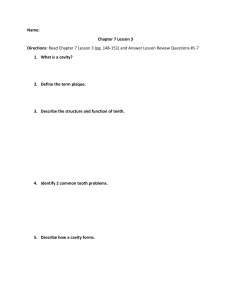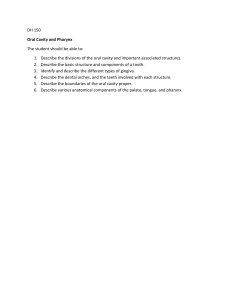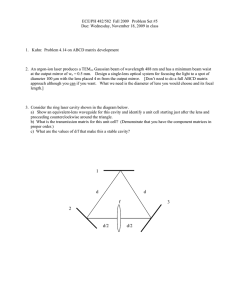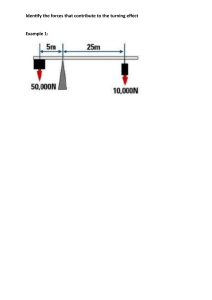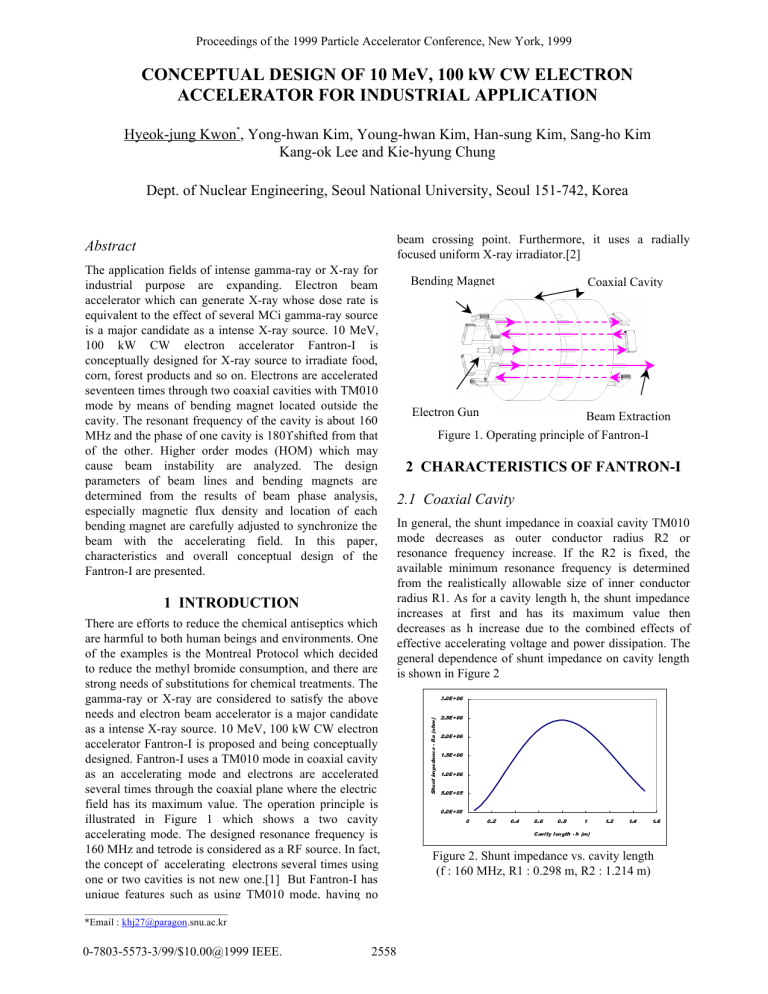
Proceedings of the 1999 Particle Accelerator Conference, New York, 1999 CONCEPTUAL DESIGN OF 10 MeV, 100 kW CW ELECTRON ACCELERATOR FOR INDUSTRIAL APPLICATION Hyeok-jung Kwon*, Yong-hwan Kim, Young-hwan Kim, Han-sung Kim, Sang-ho Kim Kang-ok Lee and Kie-hyung Chung Dept. of Nuclear Engineering, Seoul National University, Seoul 151-742, Korea beam crossing point. Furthermore, it uses a radially focused uniform X-ray irradiator.[2] The application fields of intense gamma-ray or X-ray for industrial purpose are expanding. Electron beam accelerator which can generate X-ray whose dose rate is equivalent to the effect of several MCi gamma-ray source is a major candidate as a intense X-ray source. 10 MeV, 100 kW CW electron accelerator Fantron-I is conceptually designed for X-ray source to irradiate food, corn, forest products and so on. Electrons are accelerated seventeen times through two coaxial cavities with TM010 mode by means of bending magnet located outside the cavity. The resonant frequency of the cavity is about 160 MHz and the phase of one cavity is 180° shifted from that of the other. Higher order modes (HOM) which may cause beam instability are analyzed. The design parameters of beam lines and bending magnets are determined from the results of beam phase analysis, especially magnetic flux density and location of each bending magnet are carefully adjusted to synchronize the beam with the accelerating field. In this paper, characteristics and overall conceptual design of the Fantron-I are presented. 1 INTRODUCTION There are efforts to reduce the chemical antiseptics which are harmful to both human beings and environments. One of the examples is the Montreal Protocol which decided to reduce the methyl bromide consumption, and there are strong needs of substitutions for chemical treatments. The gamma-ray or X-ray are considered to satisfy the above needs and electron beam accelerator is a major candidate as a intense X-ray source. 10 MeV, 100 kW CW electron accelerator Fantron-I is proposed and being conceptually designed. Fantron-I uses a TM010 mode in coaxial cavity as an accelerating mode and electrons are accelerated several times through the coaxial plane where the electric field has its maximum value. The operation principle is illustrated in Figure 1 which shows a two cavity accelerating mode. The designed resonance frequency is 160 MHz and tetrode is considered as a RF source. In fact, the concept of accelerating electrons several times using one or two cavities is not new one.[1] But Fantron-I has unique features such as using TM010 mode, having no ____________________________ *Email : khj27@paragon.snu.ac.kr 0-7803-5573-3/99/$10.00@1999 IEEE. 2558 Bending Magnet Coaxial Cavity Electron Gun Beam Extraction Figure 1. Operating principle of Fantron-I 2 CHARACTERISTICS OF FANTRON-I 2.1 Coaxial Cavity In general, the shunt impedance in coaxial cavity TM010 mode decreases as outer conductor radius R2 or resonance frequency increase. If the R2 is fixed, the available minimum resonance frequency is determined from the realistically allowable size of inner conductor radius R1. As for a cavity length h, the shunt impedance increases at first and has its maximum value then decreases as h increase due to the combined effects of effective accelerating voltage and power dissipation. The general dependence of shunt impedance on cavity length is shown in Figure 2 ( 6KXQW LPSHGDQFH 5D RKP Abstract ( ( ( ( ( ( &DYLW\ OHQJWK K P Figure 2. Shunt impedance vs. cavity length (f : 160 MHz, R1 : 0.298 m, R2 : 1.214 m) Proceedings of the 1999 Particle Accelerator Conference, New York, 1999 2.2 Design Guideline There are two conflicting aspects in cavity design. The required RF power is proportional to the square of the electric field intensity. As the electric field intensity decreases and the cavity crossing number increases, the required RF power can be lowered. This means that increasing the crossing number is advantageous in the respect of RF power efficiency. But as the crossing number increases, the gyroradius decreases at a fixed cavity size, which requires more magnetic flux density. Therefore the crossing number is restricted by the realistically available magnetomotive force in other words bending magnet power supply cost. After compromise between two conflicting aspects, about 200 kW RF power and 0.25 T magnetic flux density are selected as a guideline. selected to be -10° because the deviations from reference gyroradius are less than 5 mm in all the available initial phase range. The results are shown Figure 3., 4. and 5.(f=159.31 MHz, R1=0.3 m, R2=1.22 m, h=0.7 m case) The electrons which have an initial phase angle range greater than 30° can reach the final beam energy above 10 MeV as can be seen in Figure 3, but in these range, electrons with phase angle of -5°∼ -35° are within the first gyroradius deviation limit. In Figure 4, the reference electron is injected into each cavity at a fixed phase angle taking into account the stability condition except first and second injection. The optimized beam line length and magnetic flux density of the bending magnet are shown in Figure 5. The inter-cavity beam line length and straight beam line section of the bending parts are 24 cm, 86 cm respectively. The maximum magnetic flux density is 0.269 T. 2.3 Acceleration Scheme ( ( )LQDO HQHUJ\ 0H9 There can be several acceleration schemes. Using of one cavity needs many crossing numbers which require far above the value of the magnetic flux density given in section 2.2. Using two cavities can reduce the crossing number in the penalty of reduced effective accelerating voltage at the same input RF power. The crossing number can be further reduced as the cavity length increases above the values limited by the 0.5 λ synchronization condition. This scheme can be accomplished if the total length of cavity and bending section is equal to 1.5 λ and length of cavity and inter-cavity beam line is equal to 0.5 λ. ( ( ( ( ( ,QLWLDO LQMHFWLRQ DQJOH GHJUHH Figure 3. Initial injection angle vs final beam energy The equation of motion of electrons in electromagnetic field is solved numerically using fourth order Runge– Kutta method to determine the cavity length, beam line length and magnetic flux density of the bending magnet. Once the cavity length is determined from the requirement of section 3.1, initial reference phase angle should be selected to determine the other parameters which are optimized to the electrons with the initial reference phase angle. Initial reference phase angle is 2559 ( ( ( ( ( ( ( &DYLW\ FURVVLQJ QXPEHU Figure 4. Entering phase angle at each cavity ( ( ( ( ( ( ( ( ( ( ( ( ( 0DJQHWLF IOX[ GHQVLW\ 7 3.2 Beam Line and Bending Magnet ( P The 1.5 λ + 0.5 λ acceleration scheme is chosen because the crossing number can be further reduced in the penalty of accelerator size. The upper limit of the cavity length in this scheme is restricted by the available initial phase angle range of the electron beam because with large cavity length, the low energy electrons can not cross the cavity during the effective acceleration time interval and will be lost. The range of the available initial phase angle is chosen to be about 30° which results in 10 mA average current with 200 mA peak current. %HDP OLQH OHQJWK 6WUDLJKW VHFWLRQ 3.1 Cavity ,QMHFWLRQ DQJOH DW HDFK FDYLW\ GHJUHH ( 3 FANTRON-I PARAMETERS ( ( ( ( 'HIOHFWLRQ QXPEHU Figure 5. Magnetic flux density and beam line length Proceedings of the 1999 Particle Accelerator Conference, New York, 1999 transverse shunt impedance is shown in Figure 7. In the Figure 7, TM120 or TM121 modes have a higher shunt impedance than TM110 mode because at the beam crossing radius, TM110 mode has nearly its electric field intensity extremum but TM120 or TM121 modes have nearly magnet field intensity maximum. 3.3 Fantron-I Parameters The parameters are listed in Table 1. Table 1. Fantron-I cavity parameters Resonance frequency 159.31 MHz Inner conductor radius R1 0.3 m Outer conductor radius R2 1.22 m Cavity length 0.7 m Shunt impedance 2.39 MΩ Quality factor 51000 Number of Cavities 2 Acceleration scheme 1.5 λ + 0.5 λ Total length including deflection region 3.6 m Required RF power 220 kW Maximum magnetic flux density 0.269 T Number of bending magnets 16ea. 'LSROH 5 TM120, TM121 6KXQW LPSHGDQFH RKP ( ( ( TM110 ( ( ( ( )UHTXHQF\ 0+] Figure 7. Transverse shunt impedance (dipole mode) 4 HIGHER ORDER MODES 5 CONCLUSIONS AND FURTHER WORK 4.1 Monopole Modes In general cylindrical cavity, only longitudinal beam coupling impedance exists in monopole modes because the electric field intensity from all the monopo1e modes have its extremum at the beam crossing axis (usually center axis of the cavity). But the electric field of higher order mode has not extremum at the beam crossing axis in Fantron-I cavity, so transverse beam coupling impedance exists inevitably. The transverse coupling impedance can be derived from Panofsky-Wenzel theorem.[3] The longitudinal and transverse shunt impedances are shown in Figure 6. 0RQRSROH 5 6KXQW LPSHGDQFH RKP ( ( ( ( 5BORQ 5BWUD ( ( ( ( )UHTXHQF\ 0+] Figure 6. Longitudinal and transverse shunt impedances (monopole mode) 4.2 Dipole Modes In Fantron-I cavity, the dipole mode can be generated if the center of the average beam crossing radius is shifted from the cavity center. Some assumptions are made to simplify the problem. In the simplified model, the beam is assumed to be shifted ∆r in radial direction at two points which is separated 180° from each other. The 2560 The design study on 10 MeV, 100 kW CW electron accelerator Fantron-I is presented. According to the characteristics of the Fantron-I, some compromises between required RF power and magnetic flux denstiy of the bending magnet should be done. Basic parameters were derived and cavity HOMs were calculated. In the future, focusing elements should be added. The beam instabiliy caused by HOMs should be analyzed and damper may be added if necessary. 6 REFERENCE [1]. J. Pottier, “A new type of RF electron accelerator : the rhodotron”, Nucl. Instr. Meth. Phys. Res., Vol B40/41, pp943-945, 1989 [2]. Young-hwan Kim, “Design of radially focused uniform X-ray source” in these proceeding [3]. S. Turner, Proc.of CAS - RF Engineering for particle accelerators, 1992
